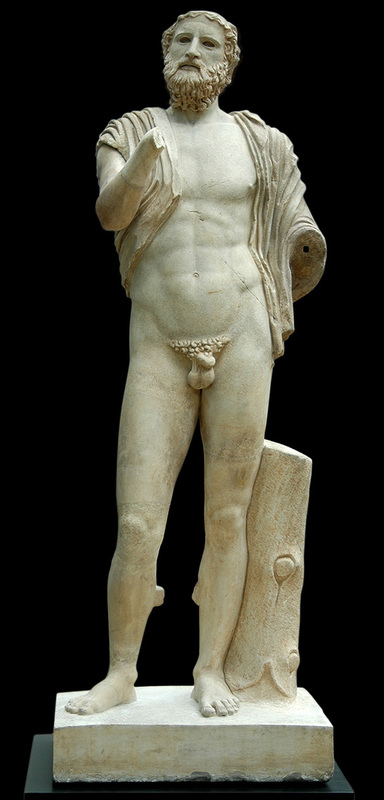Anacreon
Title
Date
Artist or Workshop
Materials
Height of the work
Provenience
Current Location
Sitter Biography
Description and Significance
Description:
Anacreon is standing, naked, next to a tree stump, which has one notch facing outward. He is looking slightly upward and to his right, and his blank expression reflects that he is performing an act that requires some manner of attention. He has slightly pronounced cheekbones beneath his hollowed-out and slightly baggy eyes, emphasized further by his wrinkle-free skin. Below his average-sized nose, he has slightly parted lips, surrounded by a thick moustache which gives way into a thick, wavy, and curly beard, which covers all of his neck from the front. His beard, however, does not extend forward past his chin, and flows naturally into his wavy and thick hair, whose curly locks form a covering over his head that, while dense with curls, does not extend far out. The top of his head, from his hairline in the front, to the height of the top of his slightly concealed ears in the back, is missing, and there is also a featureless ridge, sloping gently downwards towards the back of his head, in the left side of his hair. Anacreon stands with his left foot pointing straight forward, perpendicular with the stump, while his right foot is turned away from his body. His left foot is placed directly beneath his left hip, while his right foot is stationed just beyond his right hip. Both of his feet, with trimmed toenails and delicate ankles, are flat on the ground. His thin calves, which have spurs about halfway between the knee and the foot, are short; they are about half the height of his thighs, and they rest below his thin kneecaps. Anacreon's left leg is erect, while his right leg is slightly bent and relaxed, suggesting his weight is focused on his left side. This is mirrored in his shoulders, which slant slightly downwards from left to right. His torso is very youthful and muscular; he has pronounced collarbones, large pectoral muscles, visible abdominal muscles, and a noticeable "Apollo's belt," which forms a semicircular ridge from the edge of his abdominal muscles to the top of his groin. His shoulders, back, arms, and his right pectoral muscle are covered by a light cloak. His left elbow is bent in a way that would suggest his forearm would be extending outwards, while the rest of his arm is at his side. His right arm, also at his side, is curled upwards; these two arms, together, indicate that he was likely holding a non-extant lyre.
Significance:
This statue of Anacreon is emblematic of common traits among Classical Greek portraiture. Especially in high Classical Greek portraiture, individualizing elements of a person's face were placed over what the Greeks believed to be archetypical features of the ideal "person of thought" or "person of action." For example, there are enough unique features of this statue to indicate that it is Anacreon, based on a herm inscribed with his name, but his fit physique, wrinkle-free skin, and youthful expression indicate that this statue is an idealized form of how Anacreon may have actually looked. Anacreon shares similarities, including his long beard and expressionless face, with later Athenian "men of thought." In the case of these "men of thought," a naturalistic rather than realistic approach was taken: each portrayal of a thinker began as a "mask," or archetypical form of a thinker in the Greek conception, and then individualizing features were added. In this way, Classical portraiture, according to J.D. Breckenridge, aligned itself with Platonic philosophy, which claims that the physical body is disconnected with the inner soul, while Hellenistic portraiture agrees with Aristotelian philosophy, which asserts the opposite claim. Elements of the statue, including the non-extant poet's ribbon and lyre or wine cup, are emphasized more than the unique characteristics of Anacreon's physical body. Thus, in the supposed original context of this statue in the Athenian Acropolis, viewers were meant to understand this statue not as a reflection of Anacreon as a human being, but through his civic duty to the polis: his poetry. He is nude, which is a trait carried over by athlete statuary into the realm of "hero monuments;" in this way, Anacreon is also a hero to the Athenian state by virtue of his poetry.
References
Hamilton, Robin. Anacreon, Critical Survey vol. 6, no. 2, 1994, p. 275.
Johansen, Fleming. Catalogue: Greek Portraits in the Ny Carlsberg Glyptotek, Ny Carlsberg Glyptotek, 1992, pp. 18-21.
Pollitt, Jerome J. Art in the Hellenistic Age, Cambridge University Press, 1986, pp. 59-62.
Contributor
Citation
Item Relations
This item has no relations.

